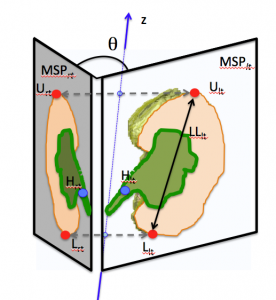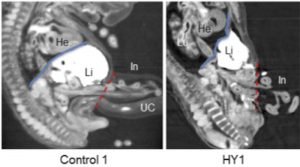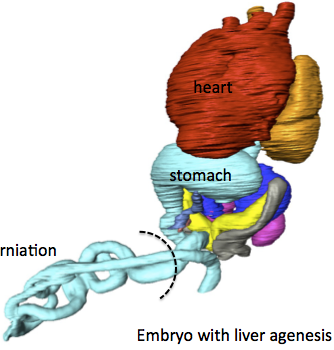腎臓の回転、移動についての論文がAnat Recに受諾されました。
腎臓が発生時に上昇し回転することは教科書に書かれています。その動きを3Dでしっかり観察したこと、集合管尿路系の形成との関連で論じたことが特徴です。
- 腎門の向きは、CS17 (34.4 度) と 18 (122.3度) の間で大幅に変化
- 尿路樹の分岐数が CS17 での1.61 から CS18で3.20 に増加
- 枝の数の増加は、後腎の成長と腎門の方向に影響を与えた。
石山さんの修士の仕事に石川さんがデータを追加してくれました。
37. Ishiyama H, Ishikawa A, Imai H, Matsuda T, Yoneyama A, Yamada S, Takakuwa T. Spatial relationship between the metanephros and adjacent organs according to the Carnegie stage of development. Anat Rec 2019. 302, 1887-2104. DOI: 10.1002/ar.24103
ABSTRACT
The morphological changes in the metanephros and its spatial relationship to the adjacent organs was evaluated based on the Carnegie stages (CSs) from 14 through 23. The imaging modalities used included magnetic resonance imaging (N = 4), phase-contrast X-ray computed tomography (N = 11), and serial histological sections (N = 40), supplemented by three-dimensional image reconstruction. The orientation of the hilus of the metanephros changed significantly between CS17 (34.4 ± 13.7 degrees) and 18 (122.3 ± 38.1 degrees), with an increase in the number of branches of the urinary collecting system, from 1.61 ± 0.42 at CS17 to 3.20 ± 0.35 at CS18. This increase in the number of branches influenced the growth of the metanephros and the orientation of its hilus. The right and left metanephroses were in proximity throughout the embryonic period. The local maximum interpole distances were observed at CS18 (0.87 ± 0.11 mm for the upper and 0.50 ± 0.25 mm for the lower pole). Mesenchymal tissue was observed between the metanephros and iliac arteries, as well as between the right and left metanephros. Throughout development, the position of the lower pole of the metanephros remained adjacent to the aortic bifurcation. The position of the upper pole, referenced with respect to the aortic bifurcation, increased by >2.0 mm, reflecting the longitudinal growth of the metanephros. Our findings provide a detailed description of the morphogenesis of the metanephros and of its hilus, which might contribute to our understanding of congenital malformations and malpositions of the kidneys.










